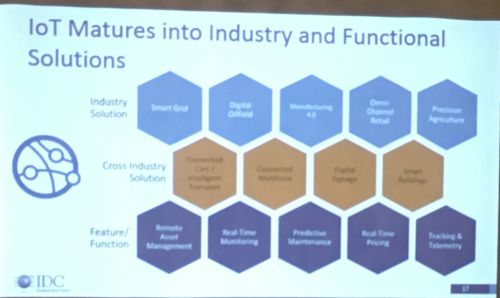2017 IDC Predictions
The Toronto Chapter held their first event of the New Year, welcoming International Data Corporation (IDC) and association members to the University Club, in downtown Toronto. The presentation of the predictions opened the floor to an interactive session for group feedback and discussion throughout the evening. Presenters and contributors for the presentation were as follows:
- Lars Goransson: General Manager & Group VP
- Tony Olvet: Group VP, Research
- David Senf: VP, Infrastructure & Cloud Technologies
- Jason Bremner: VP, Industry & Business Solutions
- JP Brouchard: VP, Mobility & Consumer
- Ron Babin: Adjunct Research Advisor & Professor at Ryerson
IDC is a global provider of advisory services, market intelligence, telecommunications, information technology and consumer technology markets. Having a presence in Canada for 30+ years, IDC around the world has a network of over 1100 analysts providing scaling services scaling from local, regional to global. IDC’s expertise in technology allows it to look long term for industry opportunities and trends within the Canadian market. Here are the 2017 IDC Predictions:
- Enterprises Focus on Digital Transformation but a Digital Divide Forms
- Mobile Device Market Stalls as Mobile Computing Rises
- Cloud Tailored to fix DX
- IoT Matures into Industry & Functional Solutions
- Enterprise Services and Software Incorporate AI & Cognitive
- Immersive Computing Opens Virtual Doors
- Organizations Will Learn About Cloud Security the Hard Way
- DX Developer Teams & Communities Become Long Term Innovation Hubs
- Robotics Reach Commercial Service Applications
- Augmented Humanity and 4th Platform on the Horizon
Let’s dive in to three of the predictions in more detail.
Enterprises Focus on Digital Transformation but a Digital Divide Forms
Digital Transformation (DX) is the change associated with the application of third platform technologies to alter how enterprises deliver products and services. Examples on these innovation accelerators include Big Data/ Analytics, Cloud, Mobility and Social. Generally, a design-led approach, the change alters the way the business operates and ultimately improvising the processes effectively.
Business Leaders are divided recognizing the impact of DX to enterprises with 31% postulating little or no impact and in contrast, 24% postulate a major impact. Amazon and Wal-Mart have been forward thinking, impacted less by the digital divide while numerous other organizations struggle to close the gap. DX initiatives in Canadian companies have resulted in new leaders to oversee initiatives, reinventing relationships with existing customers and augment processes to increase productivity and reduce costs. The impact of DX will invariably cause the gap between business leaders and employees to be amplified for innovation, growth and global competiveness.
63% of the enterprises in Canada are Digital Resisters/ Explorers, which highlights the infancy of their DX journey. Barriers prohibiting enterprises from developing further include leadership, organizational structure, people, culture, existing business models and legacy systems. On the bright side, 13% of Canadian enterprises are classified as Digital Transformers/ Disruptors, overcoming barriers to DX with trends in this classification to grow.
Mobile Device Market Stalls as Mobile Computing Rises
The number of shipments of Canadian Mobile Device continues to decline. Trending year over year, the “growth” will be nearly 0% by 2018 compared to over 50% in 2011. Mobile devices include mobile phones, notebooks and tablets. Where does that leave non-mobile computing devices i.e. Desktop Computer? These platforms will account for less than 10% of all online activity within two years. Mobile devices, especially tablets and smartphones computing power has risen to a level that Canadians can take care of their online activity which include banking, shopping, communication, media and search on their mobile devices.
Amazon’s new Go Grocery Store in Seattle, is a prime example. The store operates without checkout lines! Shoppers enter the store and scan their Amazon application, the sensors registers an item when the shoppers picks it up and automatically charges their distinct payment method within the application. The shopper leaves the store without stopping at a conventional checkout line. Another example is ApplePay, letting shoppers pay through contactless Point of Sale terminals at a growing number of retail locations.
DX Developer Teams & Communities Become Long Term Innovation Hubs
Of the Global 500, by the end of 2017 over 70% of these enterprises will have new dedicated in house teams, transformation/ innovation teams! LEGO has already started with their Future Lab! The team’s objective is to generate new ideas and find innovative ways to be competitive within their current markets and potential new markets.
To build these innovative teams, organizations will face cultural changes and must find unconventional models to source internal talents. Continuous experimentation for innovative teams is highly important to test their concepts and designs. Building an innovative lab is a challenge starting small with a core team of 2-3 extremely motivated individuals willing to learn, take risks within a safe environment and fail fast. As the team starts to grow, “experiments” become new practices throughout the company. Organizations will have to shift their culture to encourage risks and mistakes to earn grander long-term returns from the innovative hub investment.
9 Nuggets from other Predictions:
- Canadian organization will seek customized solutions from their suppliers leading to the adoption of multi-cloud architectures.
- Organization current: Strategy, People, Process and Technology are potential Pitfalls of moving to the Hybrid Cloud.
- The Cloud has led to uncertainty with headcount with IT Staff projected to be redeployed.
- The emergence of Platform as a Service (PaaS) and automated creation of Virtual Machines (VMs) will increase the cost of doing business.
- Internet of Things (IoT) will shift typical standard maintenance schedules to conditional maintenance schedules based on a prerequisite trigger.
- Canadian companies will place themselves and their consumers at risk by not looking at Cloud Security as a whole.
- Companies will start investing thousands in Augmented Reality (AR) for mix reality solutions to their multi-million dollar problems.
- By 2020, a new position, Chief Robotics Officer (CRO) will be created to look after the organization’s Robotics Unit.
- By 2025, technology will be embedded in the human body.
This article was written by our volunteers:
Keerthan (Keith) Sivanesan is currently in his final year, pursing a commerce degree in Business Technology Management at Ted Rogers School of Management, Ryerson University
 Mitchell R. Fong, PMP, CSM is a Management Consultant and Program Manager. As Board Advisor and Educational Foundation Liaison with the Project Management Institute, Mitchell's mandate is to engage the membership, grow the profession globally, and improve the quality of PMs locally.
Mitchell R. Fong, PMP, CSM is a Management Consultant and Program Manager. As Board Advisor and Educational Foundation Liaison with the Project Management Institute, Mitchell's mandate is to engage the membership, grow the profession globally, and improve the quality of PMs locally.

